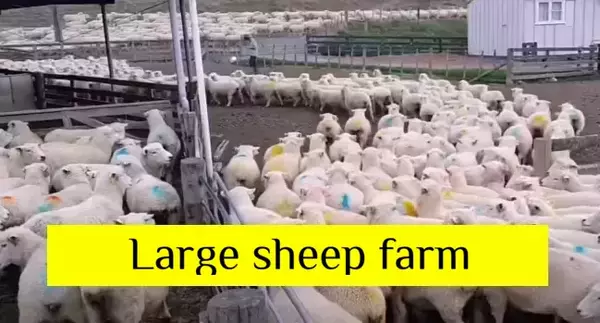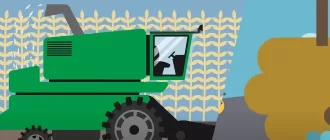Sheep breeding is not a super-profitable business, but in terms of stability and reliability a sheep farm can give many a head start.
After decades of being eclipsed by megafarms, smaller farms are making a comeback, both in terms of agricultural productivity and cattle husbandry. Even on a little plot of land, it is possible to rear sheep in a way that is profitable and successful.
Although it may be challenging to earn a profit, it is not impossible to do so if you have a large number of sheep and carefully control your expenses. Due to the fact that they may be used for food, clothing, and dairy products, sheep are a very profitable livestock option.
Lambs, which are less than a year old and belong to the sheep species, are farmed for their meat since it is regarded as being of the highest quality. Sheep are sheared once a year to collect their wool, which is a byproduct of the process. Cheeses such as pecorino, roquefort, and others like them need a special component, and that special element is milk from sheep.
Lamb Sales Boom
Timing is everything when it comes to the effective selling of items made from sheep, which is key for running a lucrative sheep business. The beginning of spring is often the time of year when prices for lamb are at their highest. Some farmers prefer to shear their sheep in the fall so that they may sell the lambs they produce in the spring. This allows the lambs to be in better condition.
However, there are certain breeds of sheep, such as the Dorset, Rambouillet, and Polypay, who have their lambs in the fall. The majority of the time, lambs are born in the late winter or the beginning of the spring, which makes them appropriate for sale in the summer or the fall. If you are able to determine when people in your area typically buy lamb, you will be better able to arrange your production properly.
Breeding
A ewe will normally give birth to anywhere from one to three lambs in a single year. The overwhelming majority of ewes give birth to two sound lambs. When compared to the profit that can be made from selling a single lamb, the profit that can be made from selling twins is much more. The ability to produce a high number of lambs at once is primarily determined by genetics.
Ewes who have already given birth to numerous offspring (either twins or triplets) have a greater chance of having more than one set of lambs. A successful sheep farm includes meticulously picking out the ewes that will be used for breeding and providing great care for the young animals.
Right Strategy for Profit
It is essential to have a plan for reaching one’s intended audience in order to be successful. Farmers that own sheep either put their animals up for sale at auction or sell them directly to butchers, restaurants, and retail outlets. Lamb is a product that some farmers sell at their stalls at farmer’s markets. Farms sometimes sell purebred sheep to other farmers to use as breeding material for their own flocks.
It is impossible to sell wool or milk from sheep if there is nowhere for them to be sold. Find out more information about the marketplace for organic products in your area. Although it is more costly to grow sheep that may be certified as organic, there is a premium price for organic meat.
Profit Calculation
As can be seen from the revenue, a flock consisting of 104 animals (four rams and one hundred ewes) needs a regular budget. It demonstrates annual costs as well as earnings using farm prices for slaughter lambs ranging from $63 to $75 per hundredweight (cwt).
If wool fetches a price of $10.10 per ewe and we are able to get 129 lambs out of every 100 ewes, then the average annual income per sheep is $106.98 when we include a cost of $75 per cwt for the lambs.
Feed and labor make up the majority of the variable costs, which range from $74.45 to $77.03 per ewe.
The average amount of fixed expenses associated with one sheep is $12.77. This accounts for the interest. This translates to a price tag of $87–$89 for each individual in attendance.
Hire More Stuff for Business Development
During certain times of the year, farming sheep involves a significant amount of labor. During the whole lambing season, both the mother sheep and her newborn lambs need specialized care and attention. Sheep that are maintained on hay need daily care and attention.
Different types of management, such as cutting the feet, shearing the hair, tagging the ears, and docking the tails, all need the knowledge of experienced professionals. Employing help from outside sources might be costly, but relying on family members can help keep costs down.
Feeding: Looking to Cheap Solutions
Feed expenses may rapidly become a significant financial burden while breeding sheep. The forage and hay that ruminants eat make up the vast part of their diet. Unfortunately, there is little land available, which makes bulk production of feed impossible. Finding hay or grazing land that is of a good quality but not too expensive is essential to generating a profit.
More Questions to Ask Yourself Before You Start
Do you have adequate buildings to accommodate the amount of ewes and lambs you wish to keep through the winter? Each ewe will need around 15 square feet of space. As a result, if you have 280 ewes, you will need 15 times 280 square feet, or 4,200 square feet, for the sheep. (The precise quantity may vary depending on the kind of manufacturing you choose.)
Dry (non-lactating) ewes don’t need much protection in the dead of winter if they’re adequately fed; ewes with young lambs in January, on the other hand, do. Sheep may be kept in a variety of buildings, such as antique dairy barns, machine sheds, and outbuildings. Remember that sheep prefer a cold, dry, and open barn over a warm, humid one. They survive in the cold due to their sheepskin coat, with the exception of the short time immediately after the delivery of lambs.
Do you have the equipment and tools necessary to produce hay, manage pastures, and clean out barns? Is there a neighbor you could work something out with to assist you with this? Are there any plans to buy hay anytime soon? If you just need 100 tons of hay, it may be cheaper and simpler to purchase it rather than cultivate it yourself. This will almost certainly help you rear more ewes.
What about this if you’re looking for sheep gear? Corrals, sorting pens, lambing pens, and other enclosures will be needed, as well as appropriate fencing, such as high-tensile electric. You’ll also need some smaller tools for shearing, ear tagging, tail docking, and foot and tail cutting.
In the Financial Markets: So, how precisely do you aim to publicize your wares? Is it your intention to sell lambs for the meat business, the hot house, as feeders, in the freezer, as breeding stock, as wool, or any mix of these? Do you want to sell lambs just at specific seasons of the year, or do you want to sell lambs all year? Your customer base is a gold mine just waiting to be discovered.
Specifically, can you spare any time to properly care for the sheep? When given the time and care they need, sheep perhaps respond the best of any farm animals. Even though the duties are not difficult, they need concentrated attention and persistent work. It is critical that sheep management activities be accomplished on time. You must be able to do tasks as quickly as they are assigned to you, rather than waiting until the next week or month. You must watch the creatures to discover what they need.
Do you have the cash necessary to start your sheep farm, see it through to full production, and weather any unforeseen storms that may arise? There are no details since everyone’s financial situation is different. Before entering the sheep sector, you should properly analyze your existing financial status. Compare sheep to the other possibilities.
Sheep Protection
It is essential to protect sheep from potential threats like predators. Coyotes and stray dogs may easily take care of sheep that are not being guarded. Shepherd dogs, electrified fences, and a vigilant watch protect sheep from wolves and other dangerous animals. Sheep benefit from a comprehensive healthcare routine that includes crucial vaccines, which allows them to maintain their good health and high level of productivity.








